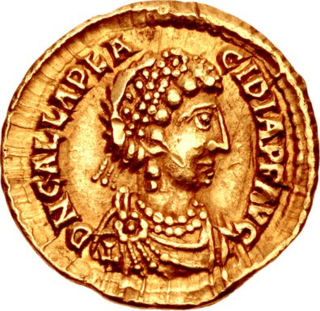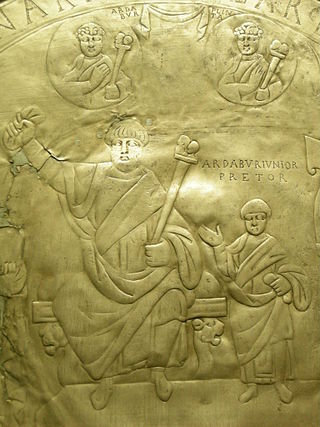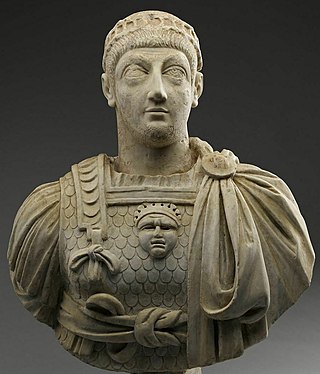
Galla Placidia, daughter of the Roman emperor Theodosius I, was a mother, tutor, and advisor to emperor Valentinian III. She was queen consort to Ataulf, King of the Visigoths from 414 until his death in 415, briefly empress consort to Constantius III in 421, and managed the government administration as a regent during the early reign of Valentinian III until her death.
The 400s decade ran from January 1, 400, to December 31, 409.
The 380s decade ran from January 1, 380, to December 31, 389.
The 430s decade ran from January 1, 430, to December 31, 439.
The 420s decade ran from January 1, 420, to December 31, 429.
Year 431 (CDXXXI) was a common year starting on Thursday of the Julian calendar. At the time, it was known as the Year of the Consulship of Bassus and Antiochus. The denomination 431 for this year has been used since the early medieval period, when the Anno Domini calendar era became the prevalent method in Europe for naming years.
The 450s decade ran from January 1, 450, to December 31, 459.

Year 427 (CDXXVII) was a common year starting on Saturday of the Julian calendar. At the time, it was known as the Year of the Consulship of Hierius and Ardabur. The denomination 427 for this year has been used since the early medieval period, when the Anno Domini calendar era became the prevalent method in Europe for naming years.

Year 434 (CDXXXIV) was a common year starting on Monday of the Julian calendar. At the time, it was known as the Year of the Consulship of Aspar and Areobindus. The denomination 434 for this year has been used since the early medieval period, when the Anno Domini calendar era became the prevalent method in Europe for naming years.

Year 450 was a common year starting on Sunday of the Julian calendar, the 450th Year of the Common Era (CE) and Anno Domini (AD designations, the 450th year of the 1st millennium, the 50th year of the half of 5th century, and the 1st year of the 450s decade. At the time, it was known as the Year of the Consulship of Valentinianus and Avienus. The denomination 450 for this year has been used since the early medieval period, when the Anno Domini calendar era became the prevalent method in Europe for naming years.
The 390s decade ran from January 1, 390 to December 31, 399
The 440s decade ran from January 1, 440, to December 31, 449.

Year 455 (CDLV) was a common year starting on Saturday of the Julian calendar. At the time, it was known as the Year of the Consulship of Valentinianus and Anthemius. The denomination 455 for this year has been used since the early medieval period, when the Anno Domini calendar era became the prevalent method in Europe for naming years.

Year 384 (CCCLXXXIV) was a leap year starting on Monday of the Julian calendar. At the time, it was known as the Year of the Consulship of Ricomer and Clearchus. The denomination 384 for this year has been used since the early medieval period, when the Anno Domini calendar era became the prevalent method in Europe for giving names to years.
Year 380 (CCCLXXX) was a leap year starting on Wednesday of the Julian calendar. At the time, it was known as the Year of the Consulship of Augustus and Augustus. The denomination 380 for this year has been used since the early medieval period, when the Anno Domini calendar era became the prevalent method in Europe for naming years.
Year 425 (CDXXV) was a common year starting on Thursday of the Julian calendar. At the time, it was known as the Year of the Consulship of Theodosius and Valentinianus. The denomination 425 for this year has been used since the early medieval period, when the Anno Domini calendar era became the prevalent method in Europe for naming years.
Year 449 (CDXLIX) was a common year starting on Saturday of the Julian calendar. At the time, it was known as the Year of the Consulship of Astyrius and Romanus. The denomination 449 for this year has been used since the early medieval period, when the Anno Domini calendar era became the prevalent method in Europe for naming years.

Valentinian III was Roman emperor in the West from 425 to 455. Starting in childhood, his reign over the Roman Empire was one of the longest, but was dominated by civil wars among powerful generals and the invasions of late antiquity's Migration Period.

Licinia Eudoxia was a Roman Empress, daughter of Eastern Roman Emperor Theodosius II. Her husbands included the Western Roman Emperors Valentinian III and Petronius Maximus.
In historiography, the Late or Later Roman Empire, traditionally covering the period from 284 CE to 641 CE, was a time of significant transformation in Roman governance, society, and religion. Diocletian's reforms, including the establishment of the tetrarchy, aimed to address the vastness of the empire and internal instability. The rise of Christianity, legalized by Constantine in 313 CE, profoundly changed the religious landscape, becoming a central force in Roman life. Simultaneously, barbarian invasions, particularly by the Goths and Huns, weakened the Western Roman Empire, which collapsed in 476 CE. In contrast, the Eastern Roman Empire endured, evolving into the Byzantine Empire and laying the foundations for medieval Europe.








